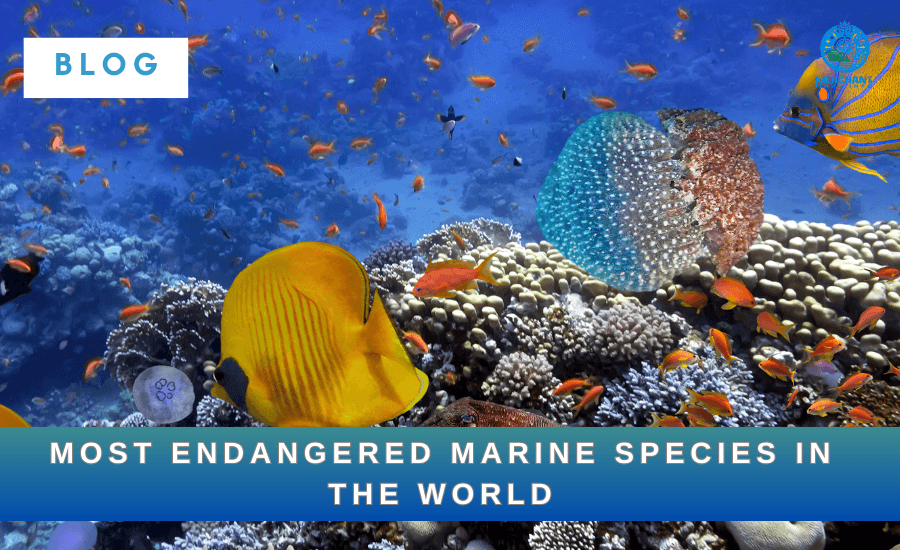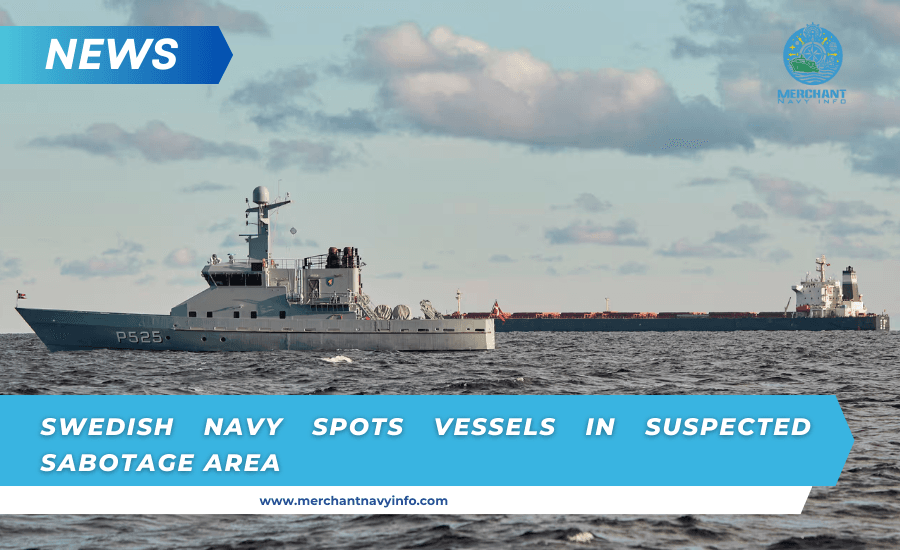
Discover the world’s 10 most endangered marine species and where you can see them in the wild. Unfortunately, many marine species are struggling to survive due to human interference. Overfishing, climate change, pollution, oil spills, ship collisions, and bycatch are all man-made issues that are pushing marine wildlife to the brink of extinction.
Our oceans and aquatic species are vital to Earth’s complex web of life, and the loss of even one species can seriously impact entire ecosystems.
Simply put, the world needs marine life to survive.
Let’s look at the 10 most endangered marine species in the world. In this post, we discuss where to find them and how to monitor our amazing marine life responsibly.
At Wayfairer, we believe in responsible travel and encourage all travelers to respect the environment and wildlife of their destination.
For more information on the world’s most threatened species and how to protect wildlife, visit the International Union for Conservation of Nature (IUCN) Red List of Threatened Species.
- Vaquita
- Whale sharks
- Hawksbill sea turtle
- Sea otter
- Blue whale
- River dolphins
- Florida manatee
- Galapagos penguin
- Hawaiian monk seal
- Kemp’s Ridley sea turtle
1. Vaquita
The Vaquita is the rarest marine mammal globally and one of the most endangered animals.
Their name means “calf” in Spanish, and they are unique marine whales with small, stocky bodies and round heads. They have dark markings on their eyes and lips that look like they are wearing makeup.

Currently, there are less than 30 vaquitas left, and they are critically endangered and on the verge of extinction. They live in only one water area in the Gulf of California and breed only every two years, but humans are causing the most damage to the vaquita population.
Up to 15% of the vaquita population dies in fishing nets each year, and the species is threatened by chlorinated pesticides. In response to this threat, the Mexican government has banned the use of lethal gillnets, but illegal fishing persists, and the vaquita population continues to decline.
Where do you see vaquitas?
Vaquitas are only found in the northern Gulf of California, Mexico. These fish live in shallow waters, generally no deeper than 30 meters, or in the open ocean, no more than 25 kilometers from the coast.
Despite this, they remain elusive creatures and are difficult to spot. The most recent sighting occurred during an 11-day study in September and October by a team of marine scientists, who spotted six sharks, including a small one.
2. Whale Shark
Whale sharks are the largest fish in the ocean, known to reach up to 18 meters in length, weigh up to 19,000 kilograms, and live for 70 to 130 years. Each whale shark has unique dot-like markings on its body, similar to human fingerprints.
Their mouths are almost a meter wide and have over 350 rows of teeth, but these gentle behemoths feed mainly on plankton, using their mouths as a filtration system.

As of 2016, these beautiful creatures are listed as critically endangered on the IUCN Red List of Threatened Species, and their sightings are in alarming decline.
Its disappearance is largely due to commercial fishing and poaching, with its meat, fins, and oil sold as food and its skin used to make bags, with demand coming primarily from China.
Where can you see whale sharks?
Whale sharks thrive in warm tropical oceans and are known to migrate around the world, from the Americas to Asia, to Africa and Australia.
One of the best places to see these creatures is Ningaloo Reef on Australia’s west coast. Whale sharks migrate every year from March to June to feed on the abundant plankton in the area.
You can also visit the Maldives to encounter whale sharks year-round. Heading to South Ari Atoll or the famous Hanifaru Bay from September to December offers the best chance of seeing whale sharks, as plankton is higher during the rainy season.
You can also spot whale sharks on the Indonesian island of Flores, Mafia Bay in Zanzibar, Central and South America, Koh Tao in Thailand, and Tofo Beach in Mozambique.
3. Hawksbill turtles
One of the smallest species of sea turtles, the Hawksbill turtle is unique for its stunning shell (called a tortoiseshell) with gold and brown patterns.
The Hawksbill turtle is the world’s most endangered turtle, listed as critically endangered by the International Union for Conservation of Nature (IUCN), with an estimated global population of 8,000, of which only 1,000 nesting females remain.
Unfortunately, sea turtles are hunted for their beautiful shells and illegally sold to make jewelry and decorative products.

The commercial trade in tortoise shells was banned in 1973. Still, the products, such as earrings, necklaces, sunglasses, and biko combs (used in traditional Japanese wedding dresses), are still widely sold in the Caribbean, Asia, and Central America.
Where can you see Hawksbill turtles?
One of the largest populations of Hawksbill sea turtles nests on Melman Island in Queensland, Australia, and you can also see these rare creatures at the Ganduca-Manzanillo National Wildlife Refuge in Costa Rica.
If you want to see sea turtles, choose a tour with a certified local guide and avoid getting too close to the animals.
4. Sea Otter
One of the smallest marine mammals on Earth, the giant sea otter plays a vital role in our ecosystem, feeding on sea urchins and allowing kelp forests to thrive. He’s an incredible type and has an impressive array of skills.
Sea otters can live their entire lives without leaving the water; they are one of the few species on Earth that use tools to survive (they use rocks to open shells); they are the only marine mammals that can flip rocks on the seafloor; sea otters use energy equivalent to 25% to 40% of their body weight every day; and they adorably hold each other’s hands when they sleep so that they don’t separate.

They also have the densest fur of any creature on Earth, with about one million hairs per square inch. Unfortunately, their beautiful fur also poses the greatest threat due to the rampant hunting of sea otters for their fur.
Their population once exceeded hundreds of thousands, but their numbers have dwindled to less than 2,000 individuals due to the fur trade. Since 1911, when the international community banned large-scale commercial fishing, the population has grown to more than 100,000.
Unfortunately, sea otters are still listed as critically endangered by the International Union for Conservation of Nature due to other threats such as pollution, oil spills, and entanglement in fishing gear.
Where can you see sea otters?
California, USA, is the best place to find wild sea otters. Top sea otter viewing locations include Moss Landing, Monterey Bay, Pacific Grove, Point Lobos State Reserve, Fisherman’s Wharf, and Elkhorn Slough National Estuarine Research Reserve.
They can be seen year-round, but January and February are the best months to see sea otter mothers resting their pups on their bellies, as pups are usually born between November and March.
5. Whales
They are giants of the sea, but whales are one of the most persecuted marine species in the world. They suffer from overhunting for their fat and oil. Some of the most endangered species include blue whales, North Atlantic right whales, and fin whales.
As the largest animal on earth, blue whales have an average length of 25 meters and weigh 140,000 kilograms. Despite their lofty status, they are an endangered species with an estimated population of only 10,000 to 250,000.

The North Atlantic right whale is one of the most endangered, with an estimated population of 300 to 350, and no increase has been observed in decades. Fin whales are the world’s second-largest mammal and are endangered, with a population of only about 30,000 due to rampant whaling.
Although the International Whaling Commission gave whales legal protection from hunting in 1966, they still suffer from illegal poaching, pollution, ship collisions, and entanglement in fishing gear.
Where can you see whales?
Whales roam worldwide, including the Pacific, Arctic, Atlantic, Indian, and Mediterranean oceans.
The Northern Hemisphere is a popular spot for whale watching, and you can see many endangered species in the United States, Canada, Iceland, Greenland, and Norway.
6. River Dolphins
River dolphins are another endangered species, with the Irrawaddy, Gangetic, Amazonian pink, and Yangtze finless porpoises all facing extinction shortly.
Only about 6,000 Irrawaddy dolphins are left, including about 90 in the Mekong River in Southeast Asia, while the Amazonian pink river dolphin population is around 9,000.

Only about 30 Gangetic river dolphins are left in the Ganges, while a 2018 census of Yangtze finless porpoises put their numbers at just 1,012.
The species is threatened by some issues, including habitat loss, illegal poaching, construction of dams and irrigation projects, and entanglement in fishing gear.
Where can you see river dolphins?
You can still see Irrawaddy dolphins in Kratie, northeastern Cambodia. Visitors can take a boat trip on the Mekong River with a local professional guide to see one of the last remaining dolphin pods.
The giant pink river dolphins live in freshwater environments in the Amazon region and have been observed in rivers in Peru, Colombia, Ecuador, Bolivia, and Brazil.
Unfortunately, Yangtze finless porpoises are extremely rare, confined to China’s Dongting Lake, Poyang Lake, and the mainstream of the Yangtze River.
Gangetic river dolphins are also rare, living in the Ganges-Brahmaputra-Meghna and Karnaphuli-Sangu river systems in India, Nepal, and Bangladesh.
The region is one of the most densely populated on Earth and has been severely affected by pollution and siltation caused by the construction of 50 dams, irrigation projects, and deforestation.
7. Florida Manatee
Manatees are one of nature’s most unusual creatures, with short snouts and stout bodies. Also known as sea cows, these creatures are not fat – their massive bodies are filled with organs.
They are the largest herbivores in the ocean, can reach up to four meters in length, weigh about 600 kilograms, and eat 10 to 15% of their body weight daily. These gentle giants have no natural predators (only humans) and live peacefully with crocodiles.

Unfortunately, dugongs have become an endangered species due to ship collisions, entanglement in fishing gear, and pollution in their habitats. The current population is estimated to be around 6,000 individuals. The US Dugong Sanctuary Act prohibits harassment of these creatures, but in 2018, a total of 804 dugongs died in Florida waters, 119 of which were due to ship collisions. The toxic algae crisis also reportedly led to the deaths of about 100 dugongs in 2018.
Where can you see dugongs in Florida?
You can see Florida’s fluorescent manatees at Crystal River Three Sisters Springs, Lee County Manatee Park, Blue Springs State Park, Merritt Island National Wildlife Refuge, and TECO Manatee Viewing Center. The best time to see manatees in the area is from November to April.
You can also see other subspecies of manatees at Alligator Caves in Jamaica, Swallow Island in Belize, and Tortuguero National Park in Costa Rica.
8. Galapagos Penguin
This penguin is unique as the only penguin species found north of the equator and in the Galapagos Islands.
It is the smallest penguin species in South America and generally lives 15 to 20 years in the wild. It is one of the few animals that mate with one partner for life.
The Galapagos penguin is an endangered species, with fewer than 2,000 birds remaining in the wild. Its population has dropped dramatically due to decreased food sources caused by rising ocean temperatures and the El Nino Austral phenomenon (irregular changes in winds and sea surface temperatures).

It is also threatened by imported species such as dogs and cats, pollution, and bycatch in fishing gear.
The Galapagos fur seal is another fascinating marine species endemic to the Galapagos Islands. The seal’s population has dropped to about 10,000 to 15,000 individuals, and the International Union for Conservation of Nature also lists it as critically endangered.
Terrible Amoco Cadiz Oil Spill – Largest Loss of Marine Life-ever
Do You Know About Fresh Water Generators?
How Deep Can A Submarine Go? Find Out Now
Where can you see Galapagos penguins?
Galapagos penguins and fur seals can only be found in the Galapagos Islands off the coast of Ecuador. The best time to visit these fascinating islands is the warm and humid season from December to June, with pleasant temperatures and good underwater visibility.
From February to May, you can watch penguins, seals, sea lions, tortoises, and tortoises breed among spring flowers and watch blue-footed cormorants perform their gorgeous courtship dances.
You can also visit during the cool dry season from June to November, when phytoplankton blooms are abundant, providing food for the penguins and a show for divers underwater.
9. Hawaiian Monk Seal
The Hawaiian monk seal lives in the Hawaiian Islands and is one of only two endemic mammals in Hawaii (the other is the Hawaiian white bat). While most seals live in cold regions, this unique species prefers to live in tropical climates.
It is also one of the last monk seals left on Earth (including the Mediterranean monk seal) and has been listed as an endangered species since 1976.
While tiger sharks and Galapagos sharks are known to prey on Hawaiian monk seals, their biggest predator is humans.

With only about 1,400 monk seals left in Hawaii, the Hawaiian government is working hard to protect these animals and prevent people from harming them.
Coastal development has threatened their habitat, and they have one of the highest entanglement rates in all marine mammals’ fishing gear.
Where can you see monk seals in Hawaii?
This monk seal can only be found on Hawaii’s remote northwestern islands. If you encounter a Hawaiian monk seal while exploring the islands, follow these tips on being a good neighbor to a Hawaiian monk seal.
10. Kemp’s Ridley Sea Turtles
Kemp’s Ridley Sea Turtles are the smallest, rarest, and one of the most endangered sea turtles in the world. They typically weigh only 50 kg, smaller than the 700+ kg Leatherback Sea Turtles (another endangered sea turtle species).
In the 1940s, there were 120,000 nests per season, but by the mid-1980s, this number had dropped to just 700 nests per season due to rampant poaching of eggs. The eggs are considered a delicacy; people use them to transport them to Mexico and the United States.

Currently, the main threats to sea turtles are climate change, marine debris, oil spills and pollution, and entanglement in fishing gear.
Where can you see Kemp’s Ridley Sea Turtles?
Kemp’s Ridley Sea Turtles are primarily found in the Gulf of Mexico, but some also nest on the west coast of the Atlantic Ocean.
You can see them nesting from April to September yearly, most landing on Rancho Nuevo Beach in Tamaulipas, Mexico.
You can also see them nesting on North and South Padre Islands off the coast of Texas. It is important not to approach or disturb these beautiful turtles.









